Staring into the face of the darkest side of guitar
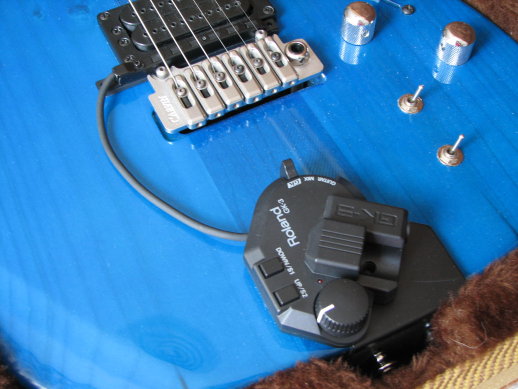 to do that, I have to bring out my keyboardist friends to record with me. You see, I don't play keyboards and I record at all sorts of odd hours, whenever schedule, family, and dogs allow. Still, to be honest, it isn’t as if synthesizers are new to me so why not try out a guitar synth? I studied synthesis when I was college, composed with synths, and worked with various controllers, but never put guitar and synth together for myself, as it were. Frankly, I wrote-off guitar synths in the ‘70s and ‘80s because at that point, their note tracking was abysmal and their interfaces hadn’t been reasonably developed. They were over-complicated, unwieldy, Frankenstenian, and expensive. Remember Pat Metheny with his one-off Synclavier synth rig? Though it sounded wonderful, it was huge, requiring multiple road cases to transport. Only an artist with a budget could have kept one of those running and afforded to lug it around. Most people thought you pretty much needed a PHD to operate it as well. However, along in the background, Roland was attempting to create an “everyman’s” guitar synth.
Their first tries were still pretty complicated and clunky for newbies, and still had poor tracking, but Roland remained committed to creating a decent, simple guitar synth. In my opinion, their current generation is exactly what they were striving for all those years. As a result of their efforts, it is possible to buy a clean-looking, synth-ready Strat and the compact Roland GR-20 synth for around $1200. You can buy the Roland DR-20 synth with a GK-3 pickup and install it yourself on a spare guitar for around half that. It’s not nearly as clean-looking but is far more economical. Okay, but how hard is installation of the GK-3 pickup? Fair question.
to do that, I have to bring out my keyboardist friends to record with me. You see, I don't play keyboards and I record at all sorts of odd hours, whenever schedule, family, and dogs allow. Still, to be honest, it isn’t as if synthesizers are new to me so why not try out a guitar synth? I studied synthesis when I was college, composed with synths, and worked with various controllers, but never put guitar and synth together for myself, as it were. Frankly, I wrote-off guitar synths in the ‘70s and ‘80s because at that point, their note tracking was abysmal and their interfaces hadn’t been reasonably developed. They were over-complicated, unwieldy, Frankenstenian, and expensive. Remember Pat Metheny with his one-off Synclavier synth rig? Though it sounded wonderful, it was huge, requiring multiple road cases to transport. Only an artist with a budget could have kept one of those running and afforded to lug it around. Most people thought you pretty much needed a PHD to operate it as well. However, along in the background, Roland was attempting to create an “everyman’s” guitar synth.
Their first tries were still pretty complicated and clunky for newbies, and still had poor tracking, but Roland remained committed to creating a decent, simple guitar synth. In my opinion, their current generation is exactly what they were striving for all those years. As a result of their efforts, it is possible to buy a clean-looking, synth-ready Strat and the compact Roland GR-20 synth for around $1200. You can buy the Roland DR-20 synth with a GK-3 pickup and install it yourself on a spare guitar for around half that. It’s not nearly as clean-looking but is far more economical. Okay, but how hard is installation of the GK-3 pickup? Fair question.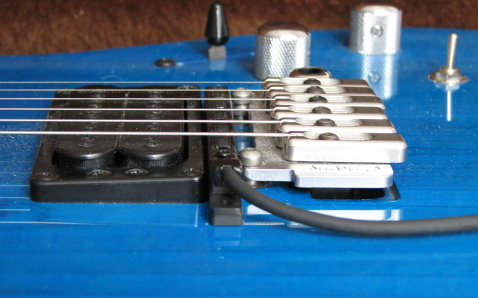 with the supplied shims and double-sided tape. Part of the reason it took that much time was because I was fastidious about the guitar finish, and I made it a temporary installation accordingly. But to be fair, it was also partly because it involved a fiddly process of stacking multiple self-stick shims to get the proper pickup height, then subtracting the height of the double-sided tape’s protective strips and re-measuring and re-stacking, before actually applying everything. Also, I had measured the horizontal space between the bridge and pickup before I bought the synth/pickup kit and according to Roland’s specs there was just enough space for the GK-3 pickup. However, at installation time, the space turned out to be a hair’s breadth too small for the pickup to fit. In order to make the synth pickup fit between the bridge pickup and the Wilkinson bridge, I took the advice from Roland's instructions and eased the screws on the bridge pickup ring, allowing it to slip a miniscule amount forward towards the neck to make space. Once the pickup was in, the control module mounted nicely via the supplied rear strap pin mount. Its cable stores beneath the control module for a clean-ish look and all the points of contact have been padded with felt, so there is little chance of finish damage. Doesn't look too Borg-esque, does it? From there, it was plugging in the guitar to the controller, the controller to the footpedal, and then making power and amp connections. Individual-string calibration to the synth took all of three or four minutes, and then I was off!
with the supplied shims and double-sided tape. Part of the reason it took that much time was because I was fastidious about the guitar finish, and I made it a temporary installation accordingly. But to be fair, it was also partly because it involved a fiddly process of stacking multiple self-stick shims to get the proper pickup height, then subtracting the height of the double-sided tape’s protective strips and re-measuring and re-stacking, before actually applying everything. Also, I had measured the horizontal space between the bridge and pickup before I bought the synth/pickup kit and according to Roland’s specs there was just enough space for the GK-3 pickup. However, at installation time, the space turned out to be a hair’s breadth too small for the pickup to fit. In order to make the synth pickup fit between the bridge pickup and the Wilkinson bridge, I took the advice from Roland's instructions and eased the screws on the bridge pickup ring, allowing it to slip a miniscule amount forward towards the neck to make space. Once the pickup was in, the control module mounted nicely via the supplied rear strap pin mount. Its cable stores beneath the control module for a clean-ish look and all the points of contact have been padded with felt, so there is little chance of finish damage. Doesn't look too Borg-esque, does it? From there, it was plugging in the guitar to the controller, the controller to the footpedal, and then making power and amp connections. Individual-string calibration to the synth took all of three or four minutes, and then I was off!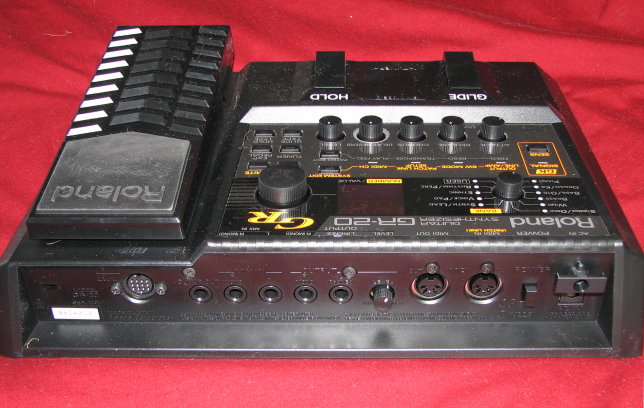 With a little practice, the mindset becomes automatic. Frankly, this thing has a pretty simple interface - much like a stomp box. Maybe that's what's needed for us bone-headed guitarists to buy one of these? You’ve got a sound category or “bank” knob and an individual sound selector knob. Twist the bank knob first to choose a sound family and then the individual patch knob for a particular sound, and you are in. You’ve got an expression pedal to change either the sound’s modulation or its volume, depending on the patch and your settings. There’s not a lot of deep patch editing available, but there’s enough to customize things a bit, if you like to fiddle. Your tweaks can be stored to a user bank. The synth offers reverb or echo for each of the patches. The controller on the guitar offers a three-way synth/guitar selector, a synth level control, and a pair of buttons that can select patches or (optionally) footswitch modes. One thing that should be mentioned is that the foot controllers could become something of a non-issue because the synth and patches are so natively playable without much external controlling. There are uses for the footswitches and expression pedal, however, so don't ignore them. Various control modes allow you to sustain a synth chord and solo over it, for instance. That's handy for solo performance work. The floor synth module offers plenty of input and output interface capabilities. All signals from the guitar travel via a single multi-pair cable. The system can output a mix of guitar and synth or it can output them separately. I might mention at this point that the footpedal synth unit is built largely of plastic, so it might not be as hard-core roadworthy as some heavier-built pedals. In the studio, I’m completely comfortable with its sturdiness. On tour, I might have some qualms about its life. Another note: Roland supplies a short guitar cable to jump between the guitar and synth controller and suggests that you always run the system with it connected. However, their short cord has straight connectors at both ends so you must remove it before putting your guitar in the case. It might be smart to pick up a short straight to angled cord so you can leave it plugged up, no?
With a little practice, the mindset becomes automatic. Frankly, this thing has a pretty simple interface - much like a stomp box. Maybe that's what's needed for us bone-headed guitarists to buy one of these? You’ve got a sound category or “bank” knob and an individual sound selector knob. Twist the bank knob first to choose a sound family and then the individual patch knob for a particular sound, and you are in. You’ve got an expression pedal to change either the sound’s modulation or its volume, depending on the patch and your settings. There’s not a lot of deep patch editing available, but there’s enough to customize things a bit, if you like to fiddle. Your tweaks can be stored to a user bank. The synth offers reverb or echo for each of the patches. The controller on the guitar offers a three-way synth/guitar selector, a synth level control, and a pair of buttons that can select patches or (optionally) footswitch modes. One thing that should be mentioned is that the foot controllers could become something of a non-issue because the synth and patches are so natively playable without much external controlling. There are uses for the footswitches and expression pedal, however, so don't ignore them. Various control modes allow you to sustain a synth chord and solo over it, for instance. That's handy for solo performance work. The floor synth module offers plenty of input and output interface capabilities. All signals from the guitar travel via a single multi-pair cable. The system can output a mix of guitar and synth or it can output them separately. I might mention at this point that the footpedal synth unit is built largely of plastic, so it might not be as hard-core roadworthy as some heavier-built pedals. In the studio, I’m completely comfortable with its sturdiness. On tour, I might have some qualms about its life. Another note: Roland supplies a short guitar cable to jump between the guitar and synth controller and suggests that you always run the system with it connected. However, their short cord has straight connectors at both ends so you must remove it before putting your guitar in the case. It might be smart to pick up a short straight to angled cord so you can leave it plugged up, no?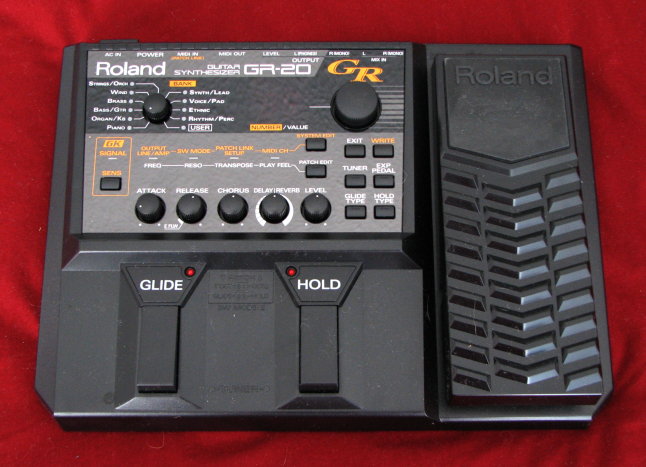 The Leslie sound is nice and swirly, even if lacking a little complexity. They've covered lots of drawbar combinations here including the usual rock and blues ones. One thing to remember is that this is very much like a keyboard synth: For solo, lead, “native instruments” to be used in the foreground, you will probably need to get a sampling synth and throw down for some expensive samples and then use this unit to control them via MIDI. In some cases the provided samples probably aren’t complex enough to fake out the modern ear as real for the foreground. The B-3 is an exception. However, for lead “synth” and background pad sounds, you are pretty well set. The bank of lead sounds offers lots of the classic lead synth sounds and they track guitar technique well, including bends, hammer-ons, and pull-offs. In the Synth/Lead bank, patch #1 sounds like Pat Metheny’s lead synth sound from the early ‘80s – Offramp and Full Circle. One of the sounds is actually called “Pat Brass.” Believe it or not, flute and piccolo, especially when teamed with glockenspiel, are very pretty when played fingerstyle. There are several voices for most of the important sounds, allowing you to find the voice that supports whatever you are trying to do. All in all, there are 469 patches available. The forty-eight voice polyphonic reproduction system means you won't be running out of voices too often, either. Some of the ethnic and novelty stuff should provide entertainment for those days when you are having a little trouble getting motivated for serious practice or rehearsal as well.
The Leslie sound is nice and swirly, even if lacking a little complexity. They've covered lots of drawbar combinations here including the usual rock and blues ones. One thing to remember is that this is very much like a keyboard synth: For solo, lead, “native instruments” to be used in the foreground, you will probably need to get a sampling synth and throw down for some expensive samples and then use this unit to control them via MIDI. In some cases the provided samples probably aren’t complex enough to fake out the modern ear as real for the foreground. The B-3 is an exception. However, for lead “synth” and background pad sounds, you are pretty well set. The bank of lead sounds offers lots of the classic lead synth sounds and they track guitar technique well, including bends, hammer-ons, and pull-offs. In the Synth/Lead bank, patch #1 sounds like Pat Metheny’s lead synth sound from the early ‘80s – Offramp and Full Circle. One of the sounds is actually called “Pat Brass.” Believe it or not, flute and piccolo, especially when teamed with glockenspiel, are very pretty when played fingerstyle. There are several voices for most of the important sounds, allowing you to find the voice that supports whatever you are trying to do. All in all, there are 469 patches available. The forty-eight voice polyphonic reproduction system means you won't be running out of voices too often, either. Some of the ethnic and novelty stuff should provide entertainment for those days when you are having a little trouble getting motivated for serious practice or rehearsal as well.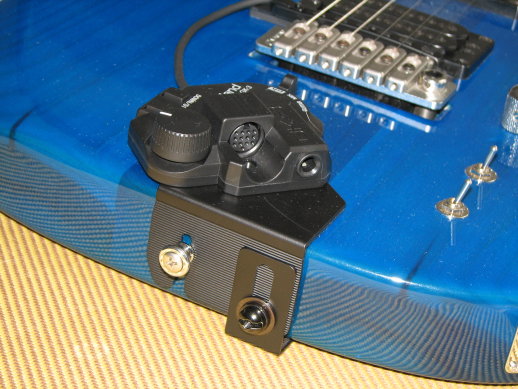 that instrument's limitations in order to produce a believable product. Fingerstyle or finger-plucked playing capability is useful in that you have the ability to individually sound and mute strings. It should be noted that by and large, instruments that can’t bend pitches won’t, and instead will just jump a half step. Instruments that can bend or slide must be manipulated like they would be on the original instrument. In some cases, a patch’s sustain envelope strictly matches the original instrument, no matter what your guitar’s sustain is like. For instance, you won’t get much fat sustain out of the harpsichord and you won’t get playing dynamics out of the B-3 organ sounds. There is one oddity surrounding guitar synthesis and the Roland synthesizer: it’s such a small market that there isn’t a whole lot of information on the ‘net. Oh, yes: Ignore the embarrassing demo videos on Roland’s website. I realize they’ve got to pitch a difficult-to-sell, literal black box to a synth-resistant market, but c’mon, folks. Some of their demonstrators comically reinforce the stereotype of the “I love me,” self-absorbed lead guitarist we’ve lived with since the ‘60s. Where's Nigel Tufnel when you need him? By contrast, there is one interesting demo from Peppino D'Agostino where he demonstrates integrating the synth with acoustic fingerstyle playing in a tasteful way.
that instrument's limitations in order to produce a believable product. Fingerstyle or finger-plucked playing capability is useful in that you have the ability to individually sound and mute strings. It should be noted that by and large, instruments that can’t bend pitches won’t, and instead will just jump a half step. Instruments that can bend or slide must be manipulated like they would be on the original instrument. In some cases, a patch’s sustain envelope strictly matches the original instrument, no matter what your guitar’s sustain is like. For instance, you won’t get much fat sustain out of the harpsichord and you won’t get playing dynamics out of the B-3 organ sounds. There is one oddity surrounding guitar synthesis and the Roland synthesizer: it’s such a small market that there isn’t a whole lot of information on the ‘net. Oh, yes: Ignore the embarrassing demo videos on Roland’s website. I realize they’ve got to pitch a difficult-to-sell, literal black box to a synth-resistant market, but c’mon, folks. Some of their demonstrators comically reinforce the stereotype of the “I love me,” self-absorbed lead guitarist we’ve lived with since the ‘60s. Where's Nigel Tufnel when you need him? By contrast, there is one interesting demo from Peppino D'Agostino where he demonstrates integrating the synth with acoustic fingerstyle playing in a tasteful way.